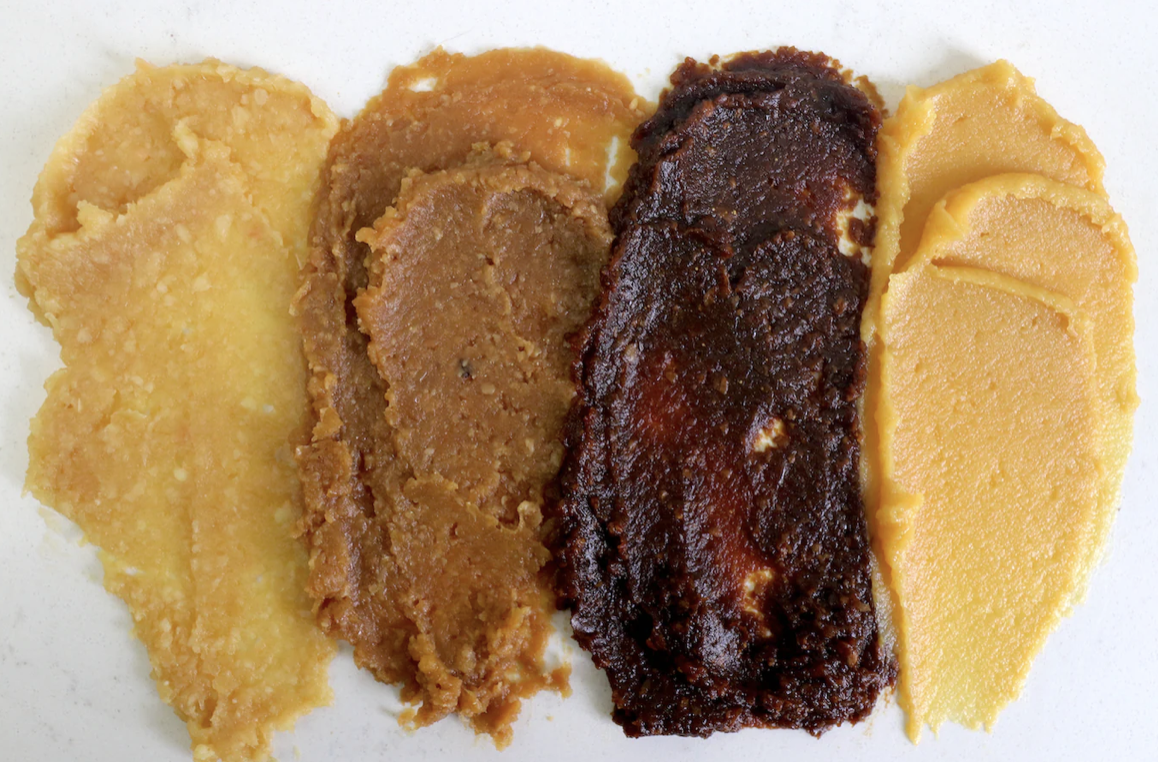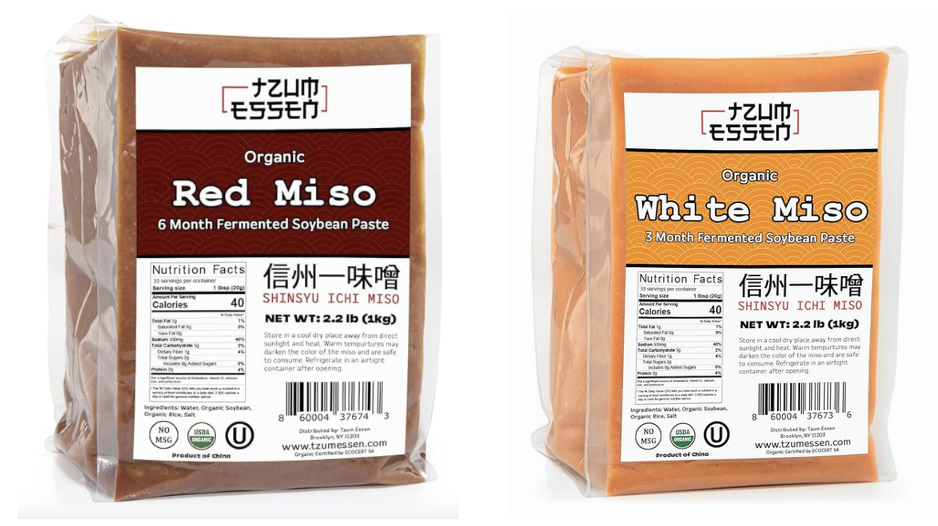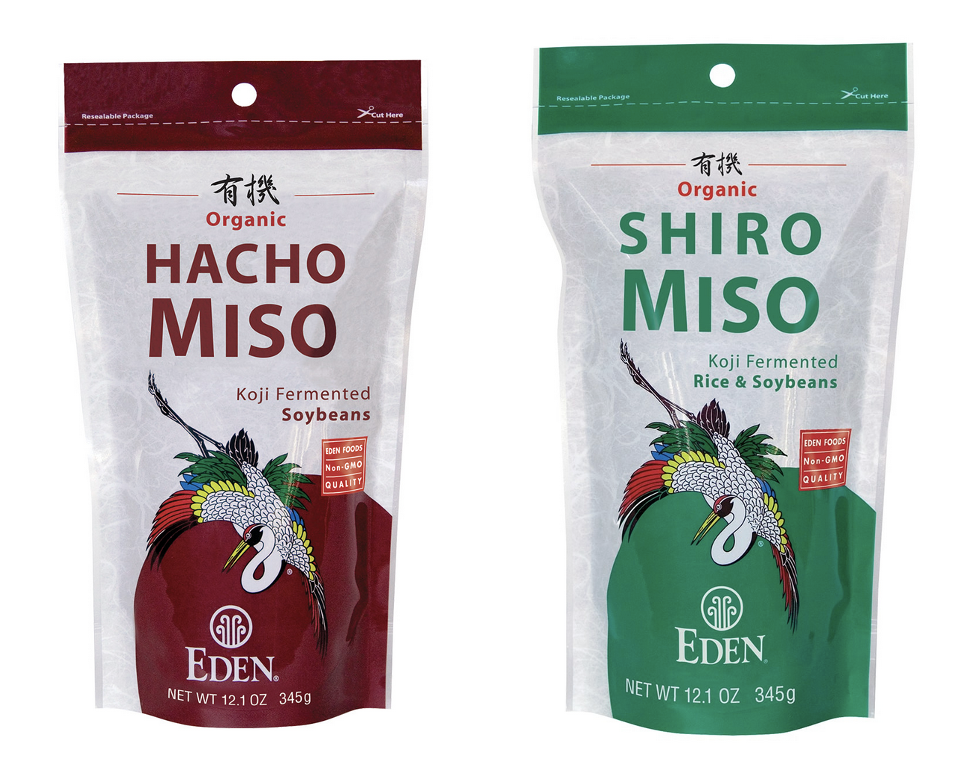Discover: Miso
By Chef David
Miso is a common element in Japanese cuisine. This paste which is made by fermenting soybeans with salt and koji (a mold cultivated on grains) gives food a distinct sweet-salty umami flavor while providing additional protein. Like other fermented foods, miso contains ‘good bacteria’ that add a complex flavor.
To make miso, soybeans are soaked in water for about 15 hours, then steamed, mashed, and cooled. The mash is mixed with koji, salt, and warm soy water (leftover from the steaming process) to form a dough-like paste. This paste is formed into a ball and placed in an air-tight fermenting container, sealed, away from light, and left to ferment for three months to a year depending on the type of miso.
Types of Miso
Miso is categorized by its base ingredient, taste, and color. It is divided into two main categories: light or white miso and dark or red miso. Light-colored miso (sometimes called sweet miso) ranges in color from light beige to yellow. It tends to be lighter and sweeter and is used in dressings and sweets, while dark miso is best for braises and stews.
- White Shiro miso is typically fermented with a large proportion of rice koji (fermented rice) and skinless soybeans that have been boiled. It undergoes a shorter fermentation time and is made with a lower soybean content and more grains. The ratio of koji to soybeans is twice as much as with other types of miso, and the amount of sea salt is much lower as well.
- Yellow Shinshu miso is made by fermenting soybeans with a koji made from barley and sometimes a small amount of rice. It uses skinless soybeans that are steamed, rather than boiled/braised to preserve umami. Shinshu adds more of an earthy flavoring than Shiro miso.
- Red miso ranges in color from light brown to almost black. It is fermented for longer and has a saltier, stronger flavor. This miso is made with a higher proportion of soybeans and salt. It is made by fermenting steamed soybeans with skin and koji made from a high concentration of barley (or other grains). Its longer fermentation gives it a nuttier-heartier profile with a deeper umami flavor.
How to Store
Store miso in a tightly sealed container in the refrigerator and it will keep for a year or longer. Light miso doesn’t last as long as the darker varieties because it is fermented for a shorter time. Miso does oxidize, placing a piece of plastic wrap directly against the paste after each use will help prevent discoloring. Because Miso does not freeze, it can be stored in the freezer.
Kosher Miso
We tried two brands of organic miso, Tzum Essen certified by the OU, and Eden certified by the OK, both are available for online purchase.
Tzum Essen which means “To eat” in Yiddish launched in Jan 2020 by Levi. Focusing on supporting the growing need of home chefs and small restaurants for authentic quality ingredients, with minimal packaging. Their products can be ordered directly through Amazon.
Our testers enjoyed and enjoyed the Red Organic Miso Paste which is fermented for six months and Shiro White Organic Miso Paste both from Tzum Essen.
From Eden Foods we tested Shiro, and Hacho, a Red Miso. Hacho is aged for three years traditionally by the Hatcho Miso Company which started over 650 years ago and uses methods dating to 1337. It is a good source of protein and has been taken on Japanese expeditions to the South Pole and fed to ancient shogun warriors for strength and endurance.
Eden miso is shelf-stable and does not require refrigeration until it has been opened.
Eden Foods
Eden Foods is a natural foods company that began in southern Michigan in 1968. It began as a cooperative where members searched for farmers to grow food using organic methods. Then it morphed into a natural food store offering whole grains, beans, soy foods, and cereals, later expanding to include a cafeteria, bakery, and books. Eden Foods was ahead of its time, created as a place to find natural, organic, and macrobiotic food. In 1972 they opened their first warehouse and established relations with artisan Japanese growers. Eden Foods has an extensive line of kosher foods, with over 300 products certified by the OK, all available online.
Expand Your Menu with Miso
There is a Japanese legend that during the ‘Age of the Gods’ a deity transferred the art of making miso to man as a gift to assure health, happiness, and longevity. We are only just beginning to understand the health benefits of fermented foods, by adding the miso flavor to your cooking you can create fast, tasty menu offerings. Miso’s salty, earthy essence introduces a subtle layer of complexity and flavor without overpowering.
Miso is so much more than soup, it will make a great addition to your pantry. Start by using sweet miso, which dissolves more easily for use in dressings, and sauces. To preserve the probiotic benefits of miso avoid boiling.
Miso is an amazing, and underappreciated protein source that will elevate classic recipes.
Two simple and satisfying recipes (below) that use Shiro (sweet) miso.
Grilled Zucchini with Miso Glaze (adapted from the NY Times)
Yield: 4 servings. Total Time: 15 minutes
Ingredients
- 4 zucchini (about 2 pounds), washed and halved lengthwise
- 3 tablespoons white miso paste
- 2 tablespoons mirin – from Eden Foods
- 2 teaspoons granulated sugar
- 1½ teaspoons soy sauce
- Neutral oil, such as vegetable (or nonstick spray)
- 2 scallions, trimmed and finely sliced (optional – for serving)
- Toasted sesame seeds (for serving)
Instructions
- Using a sharp knife (a paring knife works best), score the zucchini flesh in a crisscross pattern, do not slice all the way through.
- Make the glaze: In a small bowl, combine the miso paste, mirin, granulated sugar, and soy sauce. Add 1 tablespoon of water and whisk until combined.
- Liberally brush the cut sides of the zucchini with the glaze. Add a little oil to each piece.
- Heat a large grill pan (or a well-seasoned cast-iron skillet) over medium-high until hot. Place the zucchini, glazed side down, onto the hot surface. Press the zucchini onto the surface to encourage charring. (If you’re using a regular skillet, you may need to add more oil) Cook for 2 to 4 minutes until golden and charred.
- Flip the zucchini onto the skin side, reduce heat to medium, cover, and cook for 4 to 5 minutes until tender.
- Remove the zucchini from the pan and brush more glaze over the cut side.
- Top with sesame seeds and/ or scallions if desired. Serve and enjoy!
Easy Vegan Pressure-Cooker Miso Risotto
(adapted from Serious Eats – J. Kenji López-Alt)
Yield: 4-6 servings – Total Time: 20 minutes
Ingredients
- 6 tablespoons extra-virgin olive oil
- 1 medium shallot, finely minced (about 1/4 cup)
- 3 medium cloves garlic, minced (about 1 tablespoon)
- 2 cups risotto rice, such as Arborio or Vialone Nano
- 3/4 cup dry sake [or substitute vermouth or dry wine]
- 2 teaspoons soy sauce
- 1/4 cup white or yellow miso paste
- 4 cups low-sodium stock
- 1/2 teaspoon fresh juice from 1 lemon
- Kosher salt
Instructions
- Heat olive oil in a pressure cooker pot over medium-high heat, stirring until shimmering, then add shallot and garlic. Cook, stirring, until just translucent (about 2 minutes).
- Add rice. Cook, stirring often until the rice is evenly coated in oil and toasted (3 to 4 minutes).
- Add wine and cook, stirring, until the wine has almost fully evaporated (2 minutes).
- Stir in soy sauce and miso paste.
- Add stock. Make sure rice and pieces of shallot or garlic are fully submerged.
- Close the pressure cooker and bring it up to low pressure. Cook at low pressure for 5 minutes, then depressurize the cooker by using the quick-release valve.
- Add lemon juice, and stir. Serve and enjoy!
Note: The risotto should be creamy. If it is too soupy or the rice is not ready, cook for a few minutes longer, until it begins to thicken.










